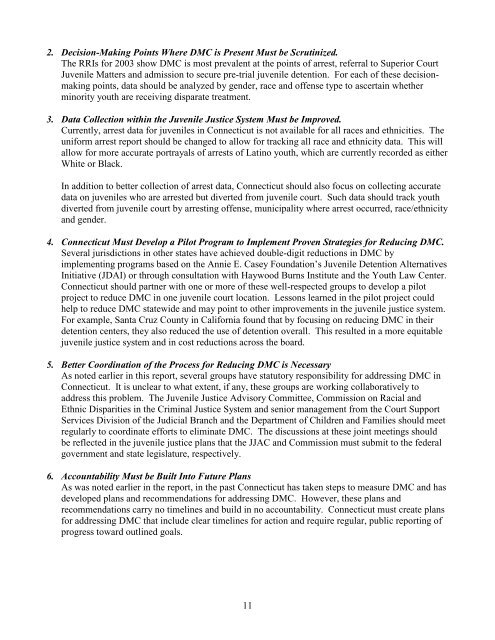Failures in Addressing DMC in Connecticut's Juvenile Justice System
Failures in Addressing DMC in Connecticut's Juvenile Justice System
Failures in Addressing DMC in Connecticut's Juvenile Justice System
Create successful ePaper yourself
Turn your PDF publications into a flip-book with our unique Google optimized e-Paper software.
2. Decision-Mak<strong>in</strong>g Po<strong>in</strong>ts Where <strong>DMC</strong> is Present Must be Scrut<strong>in</strong>ized.The RRIs for 2003 show <strong>DMC</strong> is most prevalent at the po<strong>in</strong>ts of arrest, referral to Superior Court<strong>Juvenile</strong> Matters and admission to secure pre-trial juvenile detention. For each of these decisionmak<strong>in</strong>gpo<strong>in</strong>ts, data should be analyzed by gender, race and offense type to ascerta<strong>in</strong> whetherm<strong>in</strong>ority youth are receiv<strong>in</strong>g disparate treatment.3. Data Collection with<strong>in</strong> the <strong>Juvenile</strong> <strong>Justice</strong> <strong>System</strong> Must be Improved.Currently, arrest data for juveniles <strong>in</strong> Connecticut is not available for all races and ethnicities. Theuniform arrest report should be changed to allow for track<strong>in</strong>g all race and ethnicity data. This willallow for more accurate portrayals of arrests of Lat<strong>in</strong>o youth, which are currently recorded as eitherWhite or Black.In addition to better collection of arrest data, Connecticut should also focus on collect<strong>in</strong>g accuratedata on juveniles who are arrested but diverted from juvenile court. Such data should track youthdiverted from juvenile court by arrest<strong>in</strong>g offense, municipality where arrest occurred, race/ethnicityand gender.4. Connecticut Must Develop a Pilot Program to Implement Proven Strategies for Reduc<strong>in</strong>g <strong>DMC</strong>.Several jurisdictions <strong>in</strong> other states have achieved double-digit reductions <strong>in</strong> <strong>DMC</strong> byimplement<strong>in</strong>g programs based on the Annie E. Casey Foundation’s <strong>Juvenile</strong> Detention AlternativesInitiative (JDAI) or through consultation with Haywood Burns Institute and the Youth Law Center.Connecticut should partner with one or more of these well-respected groups to develop a pilotproject to reduce <strong>DMC</strong> <strong>in</strong> one juvenile court location. Lessons learned <strong>in</strong> the pilot project couldhelp to reduce <strong>DMC</strong> statewide and may po<strong>in</strong>t to other improvements <strong>in</strong> the juvenile justice system.For example, Santa Cruz County <strong>in</strong> California found that by focus<strong>in</strong>g on reduc<strong>in</strong>g <strong>DMC</strong> <strong>in</strong> theirdetention centers, they also reduced the use of detention overall. This resulted <strong>in</strong> a more equitablejuvenile justice system and <strong>in</strong> cost reductions across the board.5. Better Coord<strong>in</strong>ation of the Process for Reduc<strong>in</strong>g <strong>DMC</strong> is NecessaryAs noted earlier <strong>in</strong> this report, several groups have statutory responsibility for address<strong>in</strong>g <strong>DMC</strong> <strong>in</strong>Connecticut. It is unclear to what extent, if any, these groups are work<strong>in</strong>g collaboratively toaddress this problem. The <strong>Juvenile</strong> <strong>Justice</strong> Advisory Committee, Commission on Racial andEthnic Disparities <strong>in</strong> the Crim<strong>in</strong>al <strong>Justice</strong> <strong>System</strong> and senior management from the Court SupportServices Division of the Judicial Branch and the Department of Children and Families should meetregularly to coord<strong>in</strong>ate efforts to elim<strong>in</strong>ate <strong>DMC</strong>. The discussions at these jo<strong>in</strong>t meet<strong>in</strong>gs shouldbe reflected <strong>in</strong> the juvenile justice plans that the JJAC and Commission must submit to the federalgovernment and state legislature, respectively.6. Accountability Must be Built Into Future PlansAs was noted earlier <strong>in</strong> the report, <strong>in</strong> the past Connecticut has taken steps to measure <strong>DMC</strong> and hasdeveloped plans and recommendations for address<strong>in</strong>g <strong>DMC</strong>. However, these plans andrecommendations carry no timel<strong>in</strong>es and build <strong>in</strong> no accountability. Connecticut must create plansfor address<strong>in</strong>g <strong>DMC</strong> that <strong>in</strong>clude clear timel<strong>in</strong>es for action and require regular, public report<strong>in</strong>g ofprogress toward outl<strong>in</strong>ed goals.11
















